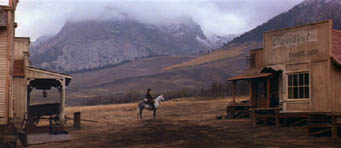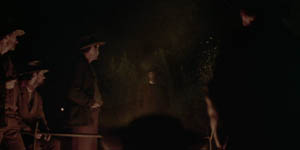|
The name Clint Eastwood is almost synonymous with westerns, despite forays into many other genres both in front of and behind the camera. This is largely due to his career-launching turn as the protagonist in Sergio Leone's Man with No Name trilogy, but in after years, Eastwood continued the tradition with many worthy examples of his own creation. And while Leone's films gave a whole new perspective on the mythology of westerns, with Pale Rider his star and protegé has created a tale which, in a very different way, feels truly mythic. 
Eastwood's craft in this film is remarkable considering that a brief synopsis reads like that of a potential hundred western pics: a small group of gold prospectors are being repeatedly harassed and threatened by the minions of a rich and greedy strip-miner who wants their legally-registered claim for himself. It's the standard political situation of most films in the genre-might makes right. (Any young punks who actually think that anarchy sounds like a cool and workable idea clearly haven't seen enough westerns.) Into their lives wanders a mysterious stranger who isn't afraid to stand up to the villainous LaHood, and he inspires the miners to band together and resist the efforts to displace them and their families. Where the film succeeds is in its clever use of imagery and suggestion to create an otherworldly feel to the proceedings. Eastwood's hero (whom he played as well as directed) is, as per usual, not entirely what he seems. After a while, however, we aren't even totally sure what he seems, either. Initially he comes across as a mercenary or gunfighter; this is thrown for a loop when we find that he's apparently a preacher (the only name by which he's ever called in the film). But this too is unclear: while calm and decent in manner, he seems equally at home with fighting, and in fact doesn't seem to do much preaching. By the end of the film, we aren't altogether sure he's even real. Fourteen year-old Megan prays for a miracle after the latest raid by LaHood's thugs results in the cruel shooting of her pet dog (if I believed in an afterlife, I'd hope for a special place in Hell for dog killers). Reciting the twenty-third Psalm over his grave, she intersperses the lines of this most famous declaration of pure and comforting faith with assertions of her own doubts and anxieties as the camera's point of view descends from the clouds in intercut vistas. Later, as she reads aloud from Revelation concerning Death and his pale steed, Preacher arrives outside her window astride an appropriately pale horse. The film is flirting with our basic assumptions; we read the scene initially as a proclamation of the danger posed by the character, of the wrath he will unleash. As the story advances, we question the metaphorical interpretation by increasing degrees. A ring of healed wounds from gunfire are seen on his back, and in one memorable scene, the camera frames him at a campfire discussion as if he is actually in the midst of the fire, wreathed in smoke. When LaHood tells him of the marshal-for-hire he intends to call to see his competition cleared aside, something stirs in Preacher, and when the marshal hears the description of his primary obstacle, he stirs as well. The mood slowly intensifies. Resting amongst the towering walls of snow-capped mountains, the setting is one which almost inevitably suggests grandeur and might beyond that of mortals. The soaring peaks dwarf the tiny human players, quiet, implacable and huge, a world mightier than anything man could muster. In this setting, the mythological almost feels natural. 
Despite a lifetime of playing characters which have often come to epitomize the macho badass, Eastwood understands subtlety and restraint, and is far too smart and skilled a director to make a definitive confirmation or renunciation of his protagonist's attachment to this mortal coil; to do so would destroy the magic he so carefully crafts throughout. Pale Rider is not a film which clumsily divulges all of its secrets, leaving final interpretations up to the individual viewer. A scene-stealer to be sure, Preacher nevetheless remains at arm's length, a negative space which serves to delineate those in his sphere: Hull, the man trying to hold onto his livelihood and hold together his would-be family, Sarah, whose last husband ran out on her and left her unable to commit to anything real, and Megan, approaching the ripe old marrrying age of fifteen and eager for her savior to show her the ways of love. Pale Rider is like a peek into a legend at its formative stage, a western that manages to expand conventions while still working within them, and a true classic of the genre. -review by Matt Murray
|
|
||||||||